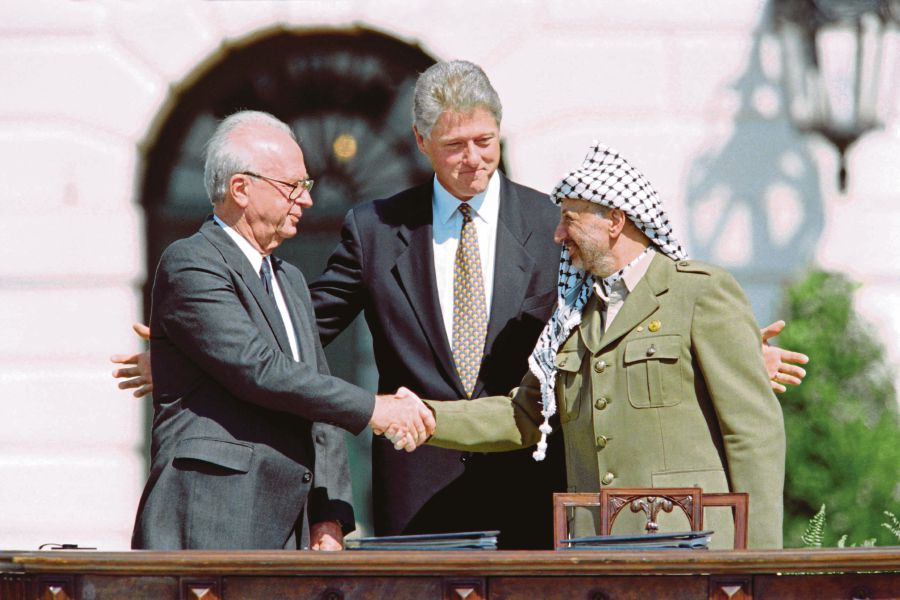Across the occupied West Bank, concrete checkpoints, separation walls and soldiers are reminders of the failure to build peace between Israelis and Palestinians since the historic Oslo Accords were signed 30 years ago this week.
The accord, intended as a temporary measure to build confidence and create space for a permanent peace agreement, has long since frozen into a system for managing a conflict with no apparent end in sight.
With the West Bank in turmoil, a nationalist government in Israel that dismisses any prospect of Palestinian statehood, and the Islamist movement Hamas flexing its muscles outside its home in Gaza, prospects for peace appear as distant as they ever have been.
Once Palestinian President Mahmoud Abbas, 87, departs, a void will be left that may bring the crisis to a head.
"We are at the end of an era in Palestine and Israel and probably in the region," said Hanan Ashrawi, a civil activist and former spokesman for the Palestinian delegation to the peace process in the 1990s.
"That whole generation — that era of talking about mutual recognition, two states, negotiated settlement, peaceful resolution — that's coming to an end in Palestine," she said.
Few on either side believe there is any realistic prospect of a two-state solution, with an independent Palestine existing side by side with Israel. The idea is just a "convenient fiction" Ashrawi said.
With barriers keeping the two sides apart in the West Bank, largely under Israeli military control, young Israelis and Palestinians have grown up knowing little of each other since the first agreement was signed on Sept 13, 1993.
"Oslo and I were born in the same year," said Mohannad Qafesha, a legal activist in the southern city of Hebron.
"To me, I was born and there were checkpoints around me, around our house. If I left home and go to the city to visit my friends, I would have to cross a checkpoint."
United Nations (UN) figures says some 700,000 Jewish settlers are established across the West Bank and East Jerusalem, the core of any future Palestinian state, and settlement building is moving ahead rapidly.
An estimated 3.2 million Palestinians live in the West Bank and 2.2 million in Gaza.
Violence over the past 18 months has seen dozens of Israelis, including civilians and soldiers, killed in attacks by Palestinians in the West Bank and Israel, and brazen attacks by Jewish settlers on Palestinian towns and villages.
Near daily raids by Israeli forces have killed hundreds of Palestinian fighters and numerous civilians, while an array of new militant groups has emerged in towns like Jenin and Nablus with little connection to the older generation of Palestinian leaders.
The structures created by the Oslo Accords, nonetheless, remain in place as the main framework for relations between Israelis and Palestinians in the absence of anything better.
The Palestinian Authority remains Israel's favoured, if often mistrusted, partner, though it lost control of Gaza when Hamas broke away in 2007.
But, dependent on foreign funds, with no electoral mandate and unpopular among its own people, it is caught between its roles as representative of the Palestinians and interlocutor with Israel.
"It's very weak, it's very poor but this agreement still exists," said Michael Milshtein, a former official for COGAT, the Israeli military body set up after Oslo to coordinate between Israel and the newly created PA.
The accords' signing brought in a brief period of optimism, symbolised by the image of Palestinian leader, Yasser Arafat and Israeli Prime Minister, Yitzhak Rabin, watched over by then US president Bill Clinton shaking hands on the White House lawn.
Rabin was assassinated by a right-wing Israeli in 1995, while Arafat died in 2004.
For Yossi Beilin, a former justice minister and Israeli negotiator, the accords' failure to bring peace came about because successive Israeli governments preferred to turn what was originally a temporary truce into a permanent status quo.
* The writer is from Reuters


